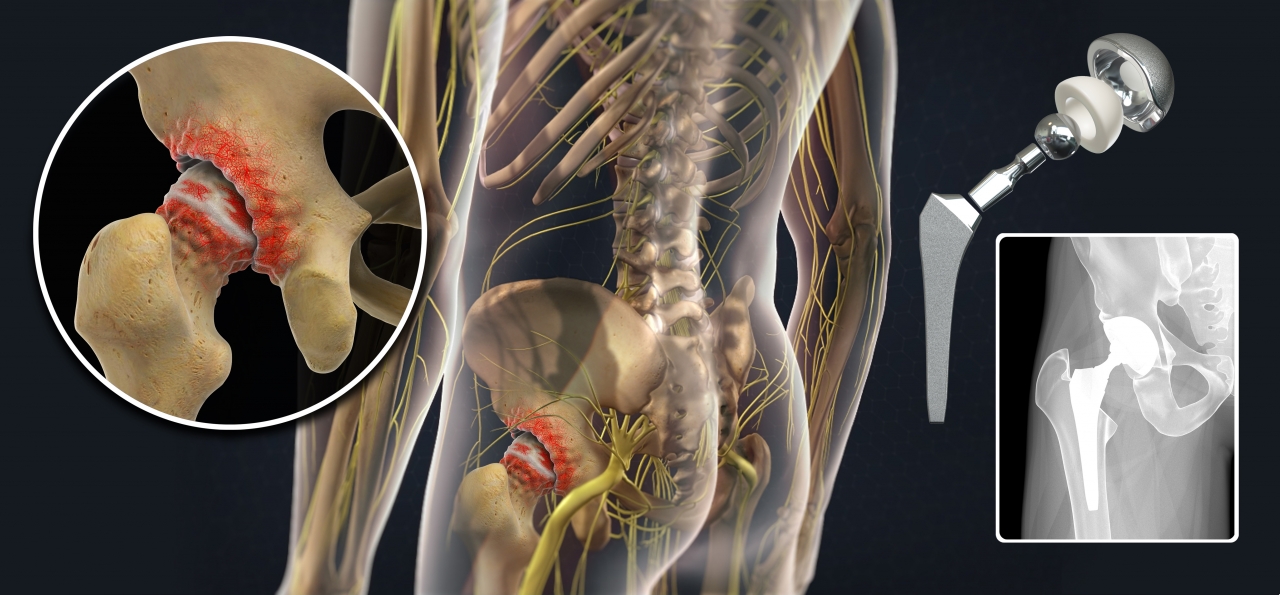Anterior Approach Versus Traditional Hip Replacement
Hip replacement surgery is one of the most successful treatment options that we as orthopedic surgeons have to offer to our patients with arthritis of their hips. Patients complain of pain, limitation of motion, and an overall decrease in their quality of life.
Hip replacement surgery benefits patients by giving them a new lease on life by improving their quality of life– whether it involves dancing, sporting activities, exercising, walking, or even the simple things such as grocery shopping, dressing, or tying your shoes.
How A Traditional Hip Replacement Is Performed
Traditionally a hip replacement is done by a posterior or posterior lateral approach. The patient is positioned on their side on the operating room table. A 6 to 8 inch incision starting around the buttocks and curving around the outside of the hip is performed.
Then, the muscles of the buttocks are split followed by detachment of 4 other muscles from the back of the hip. The hip is then dislocated at which point, we can now access the hip socket and the upper part of the hip and perform the replacement.
During this time, we replace the ball of the hip with either a metal or ceramic ball with a stem that goes into the upper part of the thigh bone and then, place a new metal socket into the pelvis with a liner made of either a durable plastic material or ceramic.
We then repair the detached muscles to the bone, bring back the buttocks muscle that was split and then close the skin.
How An Anterior Hip Replacement Is Performed
The anterior approach is an exciting new technique that we are currently performing to replace a hip. Instead of the patient lying on their side for the operation, they lie on their back. We then make a small 4 inch incision just below and to the outside of the groin.
After the skin incision, 2 muscles are identified and then pushed aside. No muscles at any time during this procedure are split or detached. We then have clear access to the hip at which point, we perform the replacement. Again, the ball and socket are replaced with either a metal or ceramic ball with a stem that goes into the upper part of the thigh bone and then, place a new metal socket into the pelvis with a liner made of either a durable plastic material or ceramic.
After completion of the procedure, we don’t have to repair any muscles that were split or detached and the skin is closed.
Q: Is anterior hip replacement surgery minimally invasive?
No hip replacement is completely minimally invasive, because it is still a major operation. Any major operation that involves anesthesia, blood loss, cutting of bone, and exposing the joint carries a certain number of risks. However, an anterior approach to hip replacement surgery is definitely less invasive than a posterior approach because of the fact that we do not split, divide, or cut muscles.
Q: Is special equipment needed to perform anterior hip replacement surgery?
The procedure can be done without any special equipment, but it is very difficult to do it that way. We are using a special table called the Hana table. We are the only ones south of Gainesville who have this table. This table was specifically designed to allow orthopedic surgeons to perform anterior hip replacement surgery with greater ease.

- Patient positioned supine on Pro-FX table
Patient’s feet are placed in boots that look like ski boots for the operation – they are then positioned on the table on their back and then during the operation we are able to position the leg in almost any position to allow access to either the ball or socket of the hip joint. The table also comes with a special hook retractor that we use to elevate the thigh bone during the operation that allows us to prepare the thigh bone or upper part of the hip for the stem portion of the replacement.
We also use a fluoroscopy machine during the operation. This is an x-ray machine that gives immediate information during the operation to help obtain better leg lengths, but also to help us place the hip replacement in the most optimal position. This is important because an artificial hip put in the best optimal position will have a lesser chance of dislocation and a better chance of lasting longer, hopefully a patient’s lifetime.
Q: Is it more expensive and does my insurance cover anterior hip replacement surgery?
It does not cost the patient any more to do the operation through an anterior approach compared to the posterior approach and all insurances cover the procedure regardless of the approach.


